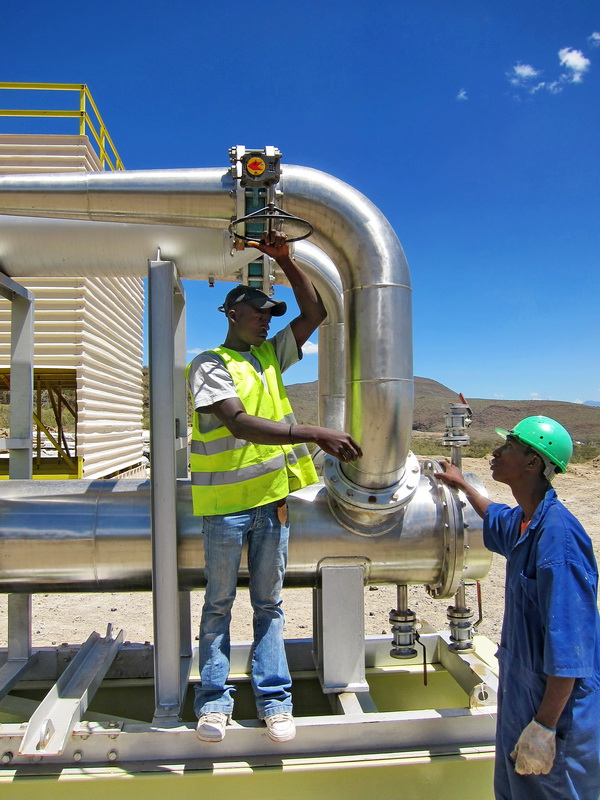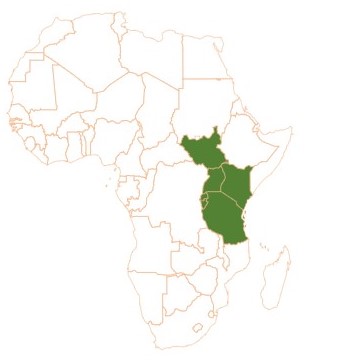|
Energy And Petroleum Regulatory Authority
The Energy and Petroleum Regulatory Authority (EPRA), formerly the Energy Regulatory Commission (ERC) is an independent regulatory authority responsible for technical and economic regulation of electricity, petroleum (Upstream, midstream and downstream) and renewable energy subsectors in Kenya. History The Electric Power Act of 1997 created the Electricity Regulatory Board (ERB) whose mandate was to regulate the electricity subsector in Kenya. Subsequent reforms in the energy sector informed the creation of the Energy Regulatory Commission through the promulgation of Energy Act No 12 of 2006 and revised in 2012. The Energy Act No 1 of 2019 repealed the Energy Act no 12 of 2006 allowing for the establishment of the Energy and Petroleum Regulatory Authority(EPRA) with and expanded mandate to regulate the entire energy sector. Location The offices of the Energy and Petroleum Regulatory Authority are located at the Eagle Africa Centre, Longonot Road, Upper Hill, Nairobi city. ... [...More Info...] [...Related Items...] OR: [Wikipedia] [Google] [Baidu] |
Nairobi
Nairobi ( ) is the capital and largest city of Kenya. The name is derived from the Maasai phrase ''Enkare Nairobi'', which translates to "place of cool waters", a reference to the Nairobi River which flows through the city. The city proper had a population of 4,397,073 in the 2019 census, while the metropolitan area has a projected population in 2022 of 10.8 million. The city is commonly referred to as the Green City in the Sun. Nairobi was founded in 1899 by colonial authorities in British East Africa, as a rail depot on the Uganda - Kenya Railway.Roger S. Greenway, Timothy M. Monsma, ''Cities: missions' new frontier'', (Baker Book House: 1989), p.163. The town quickly grew to replace Mombasa as the capital of Kenya in 1907. After independence in 1963, Nairobi became the capital of the Republic of Kenya. During Kenya's colonial period, the city became a centre for the colony's coffee, tea and sisal industry. The city lies in the south central part of Kenya, at an elevation ... [...More Info...] [...Related Items...] OR: [Wikipedia] [Google] [Baidu] |
Kenya Electricity Transmission Company
Kenya Electricity Transmission Company Limited, commonly referred to as KETRACO, is a wholly-owned parastatal of the Government of Kenya which serves as the primary Transmission System Operator in the Republic of Kenya. Location The headquarters of KETRACO are located at Kawi Complex, Popo Lane, Off Red Cross Road, in the South C neighbourhood of Nairobi Nairobi ( ) is the capital and largest city of Kenya. The name is derived from the Maasai phrase ''Enkare Nairobi'', which translates to "place of cool waters", a reference to the Nairobi River which flows through the city. The city proper h ..., the capital city of Kenya. Overview Before 2008, bulk transmission in Kenya was carried out by Kenya Power and Lighting Company. KETRACO was incorporated in December 2008 and entrusted with taking over the role of bulk electricity transmission in the country as well as maintenance of the National Transmission Grid. It is mandated to "plan, design, construct, own, operate a ... [...More Info...] [...Related Items...] OR: [Wikipedia] [Google] [Baidu] |
Energy In Kenya
This article describes energy and electricity production, consumption, import and export in Kenya. Kenya's current effective installed (grid connected) electricity capacity is 2,651 megawatts (MW), with peak demand of 1,912 MW, as of November 2019. At that time, demand was rising at a calculated rate of 3.6 percent annually, given that peak demand was 1,770 MW, at the beginning of 2018. Electricity supply is mostly generated by renewable sources with the majority coming from geothermal power and hydroelectricity. Until recently the country lacked significant domestic reserves of fossil fuel. The country has over the years had to import substantial amounts of crude oil and natural gas. This might change with the discovery of oil reserves in Kenya, which relied on oil imports to meet about 42 percent of its energy needs in 2010. As of the end of June 2016, 55% of Kenyans were connected to the National grid, which is one of the highest connection rates in Sub-Saharan Africa. Per capi ... [...More Info...] [...Related Items...] OR: [Wikipedia] [Google] [Baidu] |
Energy Markets
Energy markets are national and international regulated markets that deal specifically with the trade and supply of energy. Energy market may refer to an electricity market, but can also refer to other sources of energy. Typically energy development is the result of a government creating an energy policy that encourages the development of an energy industry in a competitive manner. Until the 1970s when energy markets underwent dramatic changes, they were characterised by monopoly-based organisational structures. Most of the world's petroleum reserves were controlled by the Seven Sisters. Circumstances changed considerably in 1973 as the influence of OPEC grew and the repercussions of the 1973 oil crisis affected global energy markets. Liberalization and regulation Energy markets have been liberalized in some countries; they are regulated by national and international authorities (including liberalized markets) to protect consumer rights and avoid oligopolies. Regulators includ ... [...More Info...] [...Related Items...] OR: [Wikipedia] [Google] [Baidu] |
Energy Regulatory Authorities
In physics, energy (from Ancient Greek: ἐνέργεια, ''enérgeia'', “activity”) is the quantitative property that is transferred to a body or to a physical system, recognizable in the performance of work and in the form of heat and light. Energy is a conserved quantity—the law of conservation of energy states that energy can be converted in form, but not created or destroyed. The unit of measurement for energy in the International System of Units (SI) is the joule (J). Common forms of energy include the kinetic energy of a moving object, the potential energy stored by an object (for instance due to its position in a field), the elastic energy stored in a solid object, chemical energy associated with chemical reactions, the radiant energy carried by electromagnetic radiation, and the internal energy contained within a thermodynamic system. All living organisms constantly take in and release energy. Due to mass–energy equivalence, any object that has mass when ... [...More Info...] [...Related Items...] OR: [Wikipedia] [Google] [Baidu] |
Energy Regulators Association Of East Africa
The Energy Regulators Association of East Africa (EREA) is a non-profit organisation mandated to spearhead harmonisation of energy regulatory frameworks, sustainable capacity building and information sharing among the List of energy regulatory bodies in the East African Community. Its key objective is to promote the independence of national regulators and support the establishment of a robust East African energy union. Foundation and mission On 28 May 2008, four national energy regulatory authorities voluntarily signed a "Memorandum of Understanding" for the establishment of the Energy Regulators Association of East Africa (EREA). Subsequently, it was recognized by the 8th Sectoral Council on Energy of East African Community (EAC) as a forum of energy regulators in the EAC on 21 June 2013. It was registered by the United Republic of Tanzania on 23 May 2019 into a company limited by guarantees and without share capital under the Companies Act, 2002, and the Memorandum of Association ... [...More Info...] [...Related Items...] OR: [Wikipedia] [Google] [Baidu] |
National Oil Corporation Of Kenya
The National Oil Corporation of Kenya (NOCK), is a state corporation of Kenya founded by Act of Parliament in 1981, with a mandate of participating in all aspects of the Kenyan petroleum industry. The company was incorporated in 1981 and began operations in 1984. Location The Head Office of the company is located at KAWI House, South C Red Cross Road, off Popo Road, Nairobi, Kenya's capital and largest city. The coordinates of the company headquarters are: 01°19'30.0"S, 36°49'55.0"E (Latitude=-1.325000; Longitude:36.831944). Service stations As of August 2018, NOCK operates 155 retail stations across Kenya, up from 115 in May 2017. Controversy In January 2016, following a company loss of KSh270 million (about US$2.7 million) for the half year period from 1 July 2015 to 31 December 2015, the NOCK board of directors sent the then managing director, Sumayya Hassan-Athmani, on compulsory leave, pending a forensic audit of the company finances. She was re-instated "three weeks lat ... [...More Info...] [...Related Items...] OR: [Wikipedia] [Google] [Baidu] |
Kenya Pipeline Company
Kenya Pipeline Company (''KPC'') is a state corporation that has the responsibility of transporting, storing and delivering petroleum products to the consumers of Kenya by its pipeline system and oil depot network. Overview The Kenya Pipeline Company was incorporated on 6 September 1973 and started commercial operations in 1978. The company is a state corporation under the Ministry of Energy with 100% government shareholding. Kenya Pipeline Company operates a pipeline system for transportation of refined petroleum products from Mombasa to Nairobi and western Kenya towns of Nakuru, Kisumu and Eldoret. Working closely with the National Oil Corporation of Kenya, KPC operates 5 storage and distribution depots for conventional petroleum products, located in Eldoret, Kisumu, Mombasa, Nairobi and Nakuru. Depots are fed by domestic-manufactured product from the Kenya Petroleum Refinery near Nairobi and imported, refined petroleum product from the Kipevu Oil Storage Facility near ... [...More Info...] [...Related Items...] OR: [Wikipedia] [Google] [Baidu] |
Kenya Power And Lighting Company
Kenya Power and Lighting Company, commonly referred to as Kenya Power or shortened KPLC, is a public liability company which transmits, distributes and retails electricity to customers throughout Kenya. Location KPLC headquarters are at Stima Plaza, Kolobot Road in Parklands, Nairobi. The coordinates of the company headquarters are: 01°16'18.0"S, 36°49'14.0"E (Latitude:-1.271668; Longitude:36.820552). Overview Kenya Power is a public company listed in the Nairobi Securities Exchange (NSE). The company is a national electric utility company, managing electric metering, licensing, billing, emergency electricity service and customer relations. In addition to electricity distribution to industry, offices, schools, hospitals, and domestic users, KPLC also offers optic fiber connectivity to telecommunication companies through its optical fiber cable network that runs along its high voltage power lines across the country mainly to manage the national power grid. History Kenya ... [...More Info...] [...Related Items...] OR: [Wikipedia] [Google] [Baidu] |
Geothermal Development Company
The Geothermal Development Company (GDC) is a wholly owned parastatal of the Government of Kenya. It is mandated to execute surface geothermal development, including prospecting for, drilling, harnessing and selling geothermal energy to electricity-generating companies for energy production and sale to the national grid. Location The headquarters of GDC are located in the capital city of Nairobi, at Kawi House, in the neighborhood known as South C. Overview The country was heavily dependent on hydroelectric energy from the time of independence until the early 2000s. Due to unpredictable rainfall patterns, the levels of the country's rivers fell and Kenya underwent a marked reduction in electricity output in the 2003 - 2006 time frame. In an attempt to reduce the over-reliance on hydroelectric energy and its susceptibility to weather changes, GDC was formed in 2008 as a Special Purpose Vehicle to carry out rapid geothermal exploration and drilling in the country to enable the ... [...More Info...] [...Related Items...] OR: [Wikipedia] [Google] [Baidu] |
Kenya
) , national_anthem = "Ee Mungu Nguvu Yetu"() , image_map = , map_caption = , image_map2 = , capital = Nairobi , coordinates = , largest_city = Nairobi , official_languages = Constitution (2009) Art. 7 ational, official and other languages"(1) The national language of the Republic is Swahili. (2) The official languages of the Republic are Swahili and English. (3) The State shall–-–- (a) promote and protect the diversity of language of the people of Kenya; and (b) promote the development and use of indigenous languages, Kenyan Sign language, Braille and other communication formats and technologies accessible to persons with disabilities." , languages_type = National language , languages = Swahili , ethnic_groups = , ethnic_groups_year = 2019 census , religion = , religion_year = 2019 census , demonym = ... [...More Info...] [...Related Items...] OR: [Wikipedia] [Google] [Baidu] |




